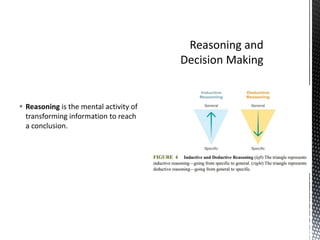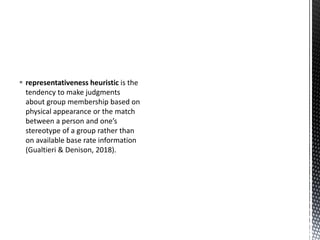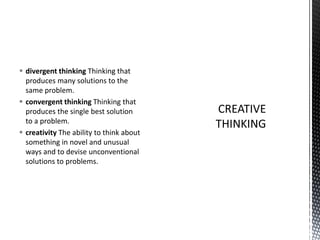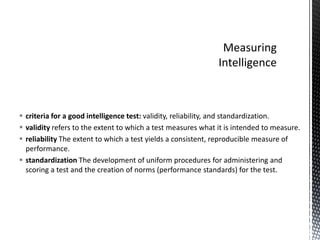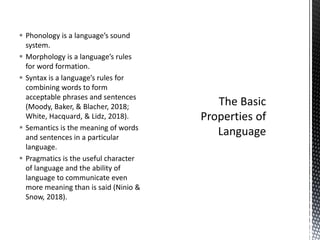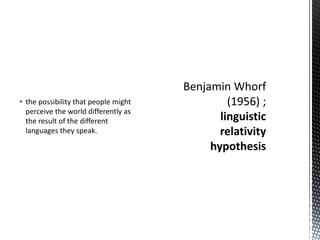Thinking, intelligence, language.pdf
- 2. ▪ Cognition refers to the way information is processed and manipulated in remembering, thinking, and knowing.
- 3. ▪ artificial intelligence (AI) A scientific field that focuses on creating machines capable of performing activities that require intelligence when they are done by people.
- 4. ▪ thinking The process of manipulating information mentally by forming concepts, solving problems, making decisions, and reflecting critically or creatively. ▪ Concepts are mental categories that are used to group objects, events, and characteristics (Goldstone, Kersten, & Carvalho, 2018).
- 5. ▪ First, they allow us to generalize. ▪ If we did not have concepts, each object in our world would be new to us each time we encountered it. Imagine having to think about how to use a chair every time you encountered a new member of the category chair. Concepts allow us to navigate the world by generalizing our experiences across members of a category.
- 6. ▪ Second, concepts allow us to associate experiences and objects. Baseball, soccer, and track are sports. The concept sport gives us a way to compare these activities. Concepts provide the net that captures the various objects, ideas, and activities that constitute an abstract idea.
- 7. ▪ Third, concepts make memory more efficient. Remember the concept of chunking in memory. Because we have a concept, many different items can be unified into a chunk, facilitating memory. ▪ Fourth, concepts provide clues about how to react to an object or experience.
- 8. ▪ problem solving The mental process of finding an appropriate way to attain a goal when the goal is not readily available.
- 9. ▪ 1. Find and Frame Problems Recognizing that a problem exists and then considering exactly what the problem involves—that is, clearly defining it—are the first steps in solving a problem. ▪ problems are ill defined or vague
- 10. 2. Develop Good Problem-Solving Strategies Once we find a problem and clearly define it, we need to develop strategies for solving it. Algorithms are strategies that guarantee a solution to a problem; they lead to a single answer that is the correct solution.
- 11. ▪ Heuristics are shortcut strategies or guidelines that suggest a solution to a problem but do not guarantee an answer (Bobadilla- Suarez & Love, 2018; Stanovich, 2018).
- 12. 3. Evaluate Solutions Once we think we have solved a problem, we will not know how effective our solution is until we find out whether it works. 4. Rethink and Redefine Problems and Solutions over Time An important final step in problem solving is to rethink and redefine problems continually.
- 13. ▪ fixation Using a prior strategy and failing to look at a problem from a new perspective. ▪ functional fixedness Failing to solve a problem as a result of fixation on a thing’s usual functions.
- 15. ▪ Reasoning is the mental activity of transforming information to reach a conclusion.
- 16. ▪ inductive reasoning Reasoning from specific observations to make generalizations. ▪ deductive reasoning Reasoning from a general case that is known to be true to a specific instance.
- 17. ▪ decision making The mental activity of evaluating alternatives and choosing among them.
- 19. ▪ hindsight bias The tendency to report falsely, after the fact, that one has accurately predicted an outcome. ▪ availability heuristic refers to a prediction about the probability of an event based on the ease of recalling or imagining similar events ▪ base rate neglect The tendency to ignore information about general principles in favor of very specific and vivid information.
- 20. ▪ representativeness heuristic is the tendency to make judgments about group membership based on physical appearance or the match between a person and one’s stereotype of a group rather than on available base rate information (Gualtieri & Denison, 2018).
- 21. ▪ Critical thinking means thinking reflectively and productively and evaluating the evidence. ▪ Mindfulness means being alert and mentally present for one’s everyday activities. ▪ Open-mindedness means being receptive to other ways of looking at things.
- 22. ▪ divergent thinking Thinking that produces many solutions to the same problem. ▪ convergent thinking Thinking that produces the single best solution to a problem. ▪ creativity The ability to think about something in novel and unusual ways and to devise unconventional solutions to problems.
- 23. ▪ Flexibility and playful thinking: Creative thinkers are flexible and play with problems. This trait gives rise to the paradox that, although creativity takes hard work, the work goes more smoothly if it is taken lightly. ▪ Inner motivation: Creative people often are motivated by the joy of creating.
- 24. ▪ Willingness to face risk: Creative people make more mistakes than their less imaginative counterparts because they come up with more ideas and more possibilities. ▪ Objective evaluation of work: Most creative thinkers strive to evaluate their work objectively.
- 25. ▪ intelligence An all-purpose ability to do well on cognitive tasks, to solve problems, and to learn from experience.
- 26. ▪ criteria for a good intelligence test: validity, reliability, and standardization. ▪ validity refers to the extent to which a test measures what it is intended to measure. ▪ reliability The extent to which a test yields a consistent, reproducible measure of performance. ▪ standardization The development of uniform procedures for administering and scoring a test and the creation of norms (performance standards) for the test.
- 27. ▪ mental age (MA) An individual’s level of mental development relative to that of others. ▪ The German psychologist William Stern devised the term intelligence quotient (IQ) in 1912. ▪ IQ consists of an individual’s mental age divided by chronological age, multiplied by 100: intelligence quotient (IQ) An individual’s mental age divided by chronological age, multiplied by 100. IQ = (MA/CA) × 100
- 28. ▪ IQ tests like the Stanford-Binet and the Wechsler scales have been given to thousands upon thousands of children and adults. ▪ When the scores for many people are examined, they approximate a normal distribution. ▪ A distribution refers to the frequencies of scores on a scale—basically, how many people receive each of the possible scores. ▪ A normal distribution is a symmetrical, bell-shaped curve, with a majority of the scores falling in the middle of the possible range and few scores appearing toward the extremes of the range.
- 30. ▪ Culture-fair tests are intelligence tests that are intended to be culturally unbiased.
- 32. ▪ Intellectual disability (or intellectual developmental disorder) is a condition of limited mental ability that affects functioning in three domains: intellectual disability or intellectual developmental disorder A condition of limited mental ability that affects an individual’s functioning in everyday life.
- 33. ▪ Language is a form of communication—whether spoken, written, or signed— based on a system of symbols
- 34. ▪ phonology A language’s sound system. ▪ morphology A language’s rules for word formation. ▪ syntax A language’s rules for combining words to form acceptable phrases and sentences. ▪ semantics The meaning of words and sentences in a particular language. ▪ pragmatics The useful character of language and the ability of language to communicate even more meaning than is verbalized.
- 36. ▪ Language is a form of communication n—whether spoken, written, or signed—that is based on a system of symbols.
- 37. ▪ Phonology is a language’s sound system. ▪ Morphology is a language’s rules for word formation. ▪ Syntax is a language’s rules for combining words to form acceptable phrases and sentences (Moody, Baker, & Blacher, 2018; White, Hacquard, & Lidz, 2018). ▪ Semantics is the meaning of words and sentences in a particular language. ▪ Pragmatics is the useful character of language and the ability of language to communicate even more meaning than is said (Ninio & Snow, 2018).
- 38. ▪ Is thought dependent on language or is language dependent on thought?
- 39. ▪ Language helps us think, make inferences, tackle difficult decisions, and solve problems. ▪ It is also a tool for representing ideas.
- 40. ▪ the possibility that people might perceive the world differently as the result of the different languages they speak.
- 41. ▪ the relationship between language and cognition is complex.
- 42. ▪ BIOLOGICAL INFLUENCE ▪ Language Universals American linguist Noam Chomsky (1975) argued that humans come into the world biologically prewired to learn language at a certain time and in a certain way.
- 43. ▪ ENVIRONMENTAL INFLUENCES ▪ the environment is crucial to language development; to stimulate children at the “critical period” for language development
- 45. ▪ Cognitive Appraisal and Stress ▪ cognitive appraisal Interpreting the events and experiences in one’s life as harmful and threatening, or as challenging, and determining whether one has the resources to cope effectively. ▪ coping Managing taxing circumstances, expending effort to solve life’s problems, and seeking to master or reduce stress.
- 46. ▪ Primary appraisal involves our immediate reactions to an event. ▪ Secondary appraisal means evaluating our resources and determining how effectively they can be used to cope with the event ▪ cognitive reappraisal Regulating one’s feelings about an experience by reinterpreting that experience or thinking about it in a different way or from a different angle.














